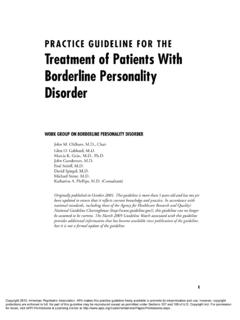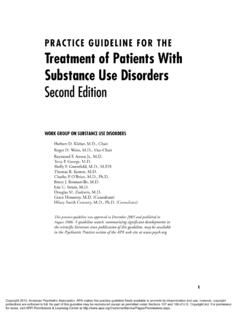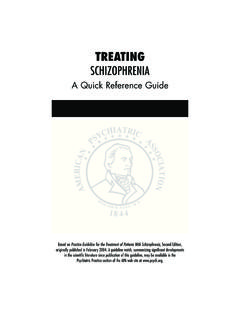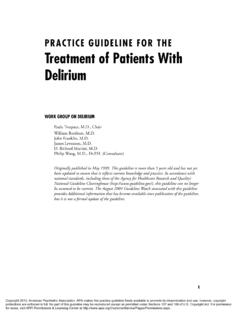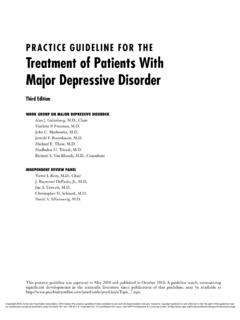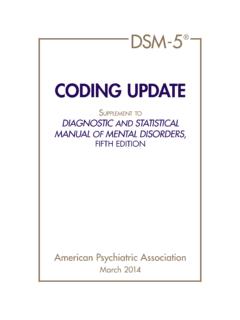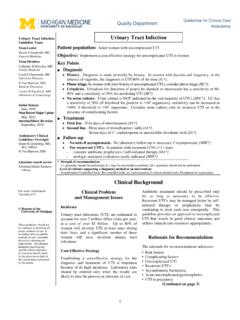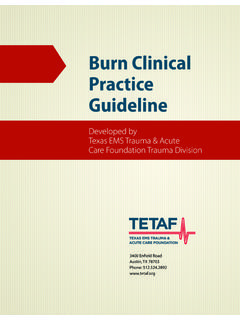Transcription of PRACTICE GUIDELINE FOR THE Treatment of …
1 1 PRACTICE GUIDELINE FOR THE Treatment of Patients With Schizophrenia Second EditionWORK GROUP ON SCHIZOPHRENIAA nthony F. Lehman, , , ChairJeffrey A. Lieberman, , Vice-ChairLisa B. Dixon, , H. McGlashan, L. Miller, O. Perkins, , Kreyenbuhl, , (Consultant)Originally published in February 2004. This GUIDELINE is more than 5 years old and has not yet been updated to ensure that it reflects current knowledge and PRACTICE . In accordance with national standards , including those of the Agency for Healthcare Research and Quality s National GUIDELINE Clearinghouse ( ), this GUIDELINE can no longer be assumed to be 2010, American Psychiatric Association. APA makes this PRACTICE GUIDELINE freely available to promote its dissemination and use; however, copyright protections are enforced in full. No part of this GUIDELINE may be reproduced except as permitted under Sections 107 and 108 of Copyright Act. For permission for reuse, visit APPI Permissions & Licensing Center at PRACTICE GuidelinesAMERICAN PSYCHIATRIC ASSOCIATIONSTEERING COMMITTEE ON PRACTICE GUIDELINESJohn S.
2 McIntyre, ,ChairSara C. Charles, ,Vice-ChairDaniel J. Anzia, A. Cook, T. Finnerty, R. Johnson, E. Nininger, Summergrad, M. Woods, , Yager, AND COMPONENT LIAISONSR obert Pyles, (Area I)C. Deborah Cross, (Area II)Roger Peele, (Area III)Daniel J. Anzia, (Area IV)John P. D. Shemo, (Area V)Lawrence Lurie, (Area VI)R. Dale Walker, (Area VII)Mary Ann Barnovitz, Hafter Gray, Saxena, Tonnu, Kunkle, , Senior Program ManagerAmy B. Albert, , Assistant Project ManagerLaura J. Fochtmann, , Medical EditorClaudia Hart, Director, Department of Quality Improvement and Psychiatric ServicesDarrel A. Regier, , , Director, Division of ResearchCopyright 2010, American Psychiatric Association. APA makes this PRACTICE GUIDELINE freely available to promote its dissemination and use; however, copyright protections are enforced in full. No part of this GUIDELINE may be reproduced except as permitted under Sections 107 and 108 of Copyright Act.
3 For permission for reuse, visit APPI Permissions & Licensing Center at of Patients With Schizophrenia3 CONTENTSS tatement of Intent .. 5 Guide to Using This PRACTICE GUIDELINE .. 6 Development Process .. 7 Part A: Treatment Recommendations for Patients With Schizophrenia.. Summary .. System .. and Implementation of a Treatment Plan .. a Therapeutic Alliance .. Phase Treatment .. Phase .. Phase .. Specific Treatment Issues .. Settings and Housing Options .. and Implementation of a Treatment Plan .. Management .. Phase .. Phase .. Phase .. Issues in Caring for Patients With Treatment -Resistant Illness .. Features Influencing the Treatment Plan .. Settings and Housing Options .. of Treatment Setting or Housing .. Treatment Settings .. 54 Part B: Background Information and Review of Available Evidence .. Definition, Natural History and Course, and Epidemiology.
4 Features .. History and Course .. and Synthesis of Available Evidence.. Treatments .. Somatic Therapies .. Psychosocial Interventions .. 104 Part C: Future Research Directions .. 114 Individuals and Organizations That Submitted Comments .. 115 References .. 116 Copyright 2010, American Psychiatric Association. APA makes this PRACTICE GUIDELINE freely available to promote its dissemination and use; however, copyright protections are enforced in full. No part of this GUIDELINE may be reproduced except as permitted under Sections 107 and 108 of Copyright Act. For permission for reuse, visit APPI Permissions & Licensing Center at 2010, American Psychiatric Association. APA makes this PRACTICE GUIDELINE freely available to promote its dissemination and use; however, copyright protections are enforced in full. No part of this GUIDELINE may be reproduced except as permitted under Sections 107 and 108 of Copyright Act.
5 For permission for reuse, visit APPI Permissions & Licensing Center at of Patients With Schizophrenia5 STATEMENT OF INTENTThe American Psychiatric Association (APA) PRACTICE guidelines are not intended to be con-strued or to serve as a standard of medical care. standards of medical care are determined onthe basis of all clinical data available for an individual patient and are subject to change as sci-entific knowledge and technology advance and PRACTICE patterns evolve. These parameters ofpractice should be considered guidelines only. Adherence to them will not ensure a successfuloutcome for every individual, nor should they be interpreted as including all proper methodsof care or excluding other acceptable methods of care aimed at the same results. The ultimatejudgment regarding a particular clinical procedure or Treatment plan must be made by the psy-chiatrist in light of the clinical data presented by the patient and the diagnostic and treatmentoptions PRACTICE GUIDELINE has been developed by psychiatrists who are in active clinical prac-tice.
6 In addition, some contributors are primarily involved in research or other academicendeavors. It is possible that through such activities some contributors, including work groupmembers and reviewers, have received income related to treatments discussed in this guide-line. A number of mechanisms are in place to minimize the potential for producing biasedrecommendations due to conflicts of interest. Work group members are selected on the basisof their expertise and integrity. Any work group member or reviewer who has a potential con-flict of interest that may bias (or appear to bias) his or her work is asked to disclose this to theSteering Committee on PRACTICE guidelines and the work group. Iterative GUIDELINE drafts arereviewed by the Steering Committee, other experts, allied organizations, APA members, andthe APA Assembly and Board of Trustees; substantial revisions address or integrate the com-ments of these multiple reviewers.
7 The development of the APA PRACTICE guidelines is notfinancially supported by any commercial detail about mechanisms in place to minimize bias is provided in a document avail-able from the APA Department of Quality Improvement and Psychiatric Services, APAG uideline Development Process. This PRACTICE GUIDELINE was approved in December 2003 and published in February 2010, American Psychiatric Association. APA makes this PRACTICE GUIDELINE freely available to promote its dissemination and use; however, copyright protections are enforced in full. No part of this GUIDELINE may be reproduced except as permitted under Sections 107 and 108 of Copyright Act. For permission for reuse, visit APPI Permissions & Licensing Center at PRACTICE GuidelinesGUIDE TO USING THIS PRACTICE GUIDELINEThe PRACTICE GUIDELINE for the Treatment of Patients With Schizophrenia, Second Edition, consistsof three parts (Parts A, B, and C) and many sections, not all of which will be equally useful forall readers.
8 The following guide is designed to help readers find the sections that will be mostuseful to A, Treatment Recommendations for Patients With Schizophrenia, is published as asupplement to the American Journal of Psychiatry and contains general and specific treatmentrecommendations. Section I summarizes the key recommendations of the GUIDELINE and codeseach recommendation according to the degree of clinical confidence with which the recom-mendation is made. Section II is a guide to the formulation and implementation of a treatmentplan for the individual patient. Section , Clinical Features Influencing the Treatment Plan, discusses a range of clinical considerations that could alter the general recommendations dis-cussed in Section II. Section III describes Treatment settings and housing options and providesguidance on choice of B, Background Information and Review of Available Evidence, and Part C, FutureResearch Directions, are not included in the American Journal of Psychiatry supplement butare provided with Part A in the complete GUIDELINE , which is available in print format fromAmerican Psychiatric Publishing, Inc.
9 , and online through the American Psychiatric Associa-tion ( ). Part B provides an overview of schizophrenia, including generalinformation on its natural history, course, and epidemiology. It also provides a structured re-view and synthesis of the evidence that underlies the recommendations made in Part A. Part Cdraws from the previous sections and summarizes areas for which more research data are neededto guide clinical share feedback on this or other published APA PRACTICE guidelines , a form is available 2010, American Psychiatric Association. APA makes this PRACTICE GUIDELINE freely available to promote its dissemination and use; however, copyright protections are enforced in full. No part of this GUIDELINE may be reproduced except as permitted under Sections 107 and 108 of Copyright Act. For permission for reuse, visit APPI Permissions & Licensing Center at of Patients With Schizophrenia7 DEVELOPMENT PROCESSThis PRACTICE GUIDELINE was developed under the auspices of the Steering Committee on Prac-tice guidelines .
10 The development process is detailed in a document available from the APAD epartment of Quality Improvement and Psychiatric Services: the APA GUIDELINE Develop-ment Process. Key features of this process include the following: A comprehensive literature review. Development of evidence tables. Initial drafting of the GUIDELINE by a work group that included psychiatrists with clinicaland research expertise in schizophrenia. Production of multiple revised drafts with widespread review; four organizations and 62individuals submitted significant comments. Approval by the APA Assembly and Board of Trustees. Planned revisions at regular literature was identified through a computerized search of PubMed for the periodfrom 1994 to 2002. Using the keywords schizophrenia OR schizoaffective, a total of 20,009citations were found. Limiting the search by using the ke words antipsychotic agents, antipsy-chotic, tranquilizing agents, aripiprazole, olanzapine, ziprasidone, quetiapine, risperidone,clozapine, glycine, beta receptor blockers, antidepressive agents, antidepressant, divalproex,valproic acid, lithium, carbamazepine, benzodiazepines, electroconvulsive therapy, communitytreatment, psychoeducation, family education, skills training, social support, rehabilitation,case management, community support, supported employment, sheltered workshop, familytherapy, family intervention, psychosocial adjustment, cognitive behavior, cognitive training,cognitive therapy, counseling, psychotherapy, group therapy, interpersonal therapy, individualtherapy, first break, first episode, new onset, early Treatment , and early detection resulted in8,609 citations.
